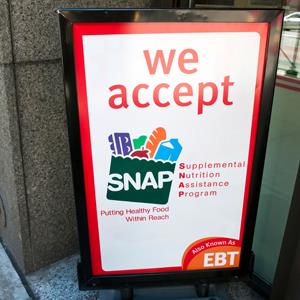How food stamps can end up feeding people abroad
Some recipients of the $75 billion federal program use the benefit to buy favorite treats for relatives in the Caribbean.
By Aimee Picchi
 Mr. and Mrs. Alderson Muncy of West Virginia made history in 1961 when they became the country's first food stamp recipients by using $95 in benefits to buy groceries for their 15-person family.
Mr. and Mrs. Alderson Muncy of West Virginia made history in 1961 when they became the country's first food stamp recipients by using $95 in benefits to buy groceries for their 15-person family.More than 50 years later, the food stamp program has changed in ways that the Muncy family probably wouldn't recognize. For one, the program now provides debit cards. Second, it has swelled into a $75 billion federal program. It's so big now that critics say it's simply too huge and is prone to abuse.
Now comes a newspaper story that won't do much to convince critics the program helps only people in need. Some families in New York City are reportedly using their benefits to buy food that they then ship to relatives in less affluent countries, such as the Dominican Republic, Jamaica and Haiti, the New York Post reports.
Transplants from the Caribbean and other island countries often send home barrels packed with food, a practice so common that sites are devoted to selling prepacked barrels (such as the Carnival Barrel from DialABarrel.com, which packs grocery favorites such as Kraft (KRFT +0.88%) BBQ sauce and Heinz ketchup).
But using food stamps to purchase food that's shipped abroad isn't kosher, a spokeswoman for the U.S. Department of Agriculture told the Post. Only households like the Muncy home -- where people buy and prepare food together -- are supposed to use the benefit. States that catch recipients of the Supplemental Nutrition Assistance Program (SNAP) shipping food abroad should intervene, the spokeswoman said.
"The purpose of this program is to help Americans who don't have enough to eat. This is not intended as a form of foreign aid," Michael Tanner, a senior fellow at the libertarian Cato Institute, told the publication.
The revelation will only add to the debate over the SNAP program, as it's part of the almost $1 trillion farm bill that's embroiled in a political fight. While the bill provides government subsidies to farmers, it also includes funding for the food stamp program. Earlier this month, House Republicans passed a version of the bill without SNAP funding. It marks the first time in 40 years that food stamps haven't been in the farm bill, The New York Times points out.
While food stamps could still end up in the final bill, the debate will likely continue for years.
No comments:
Post a Comment